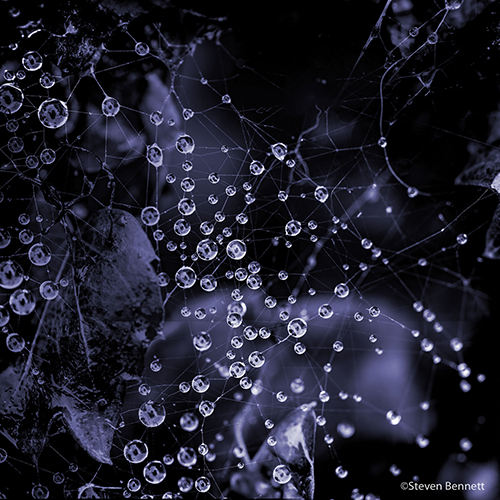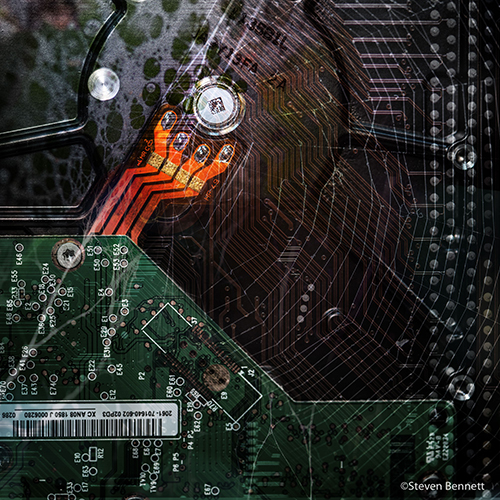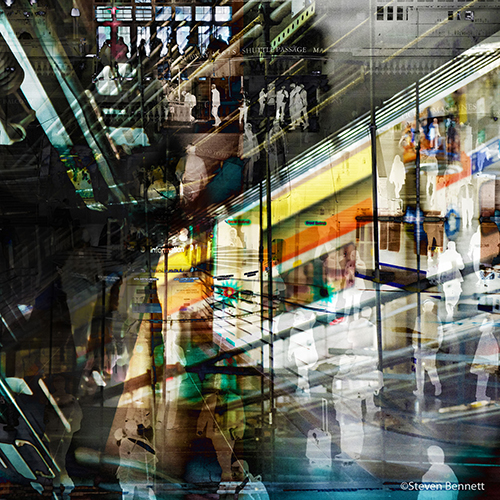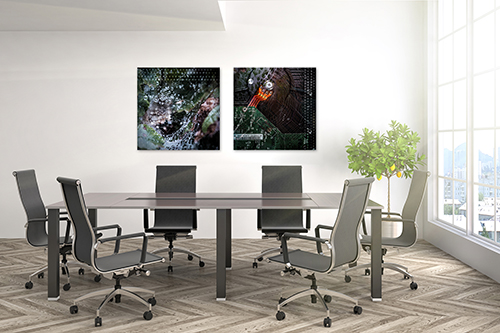by Steve Bennett
Differentiate Your Art to Rise Above the Noise
The first words that an art business consultant said to me after reviewing my portfolio were, “Your pictures of the Grand Canyon are lovely. But so are the photos of thousands of other photographers. Good luck trying to make a living selling them.” My goal was to sell into commercial markets, and I had shown her a wide range of materials that I thought might be appropriate. She recommended I concentrate instead on what makes my work unique.

“Remains of the Day,” Archival Pigment Print, 24” x 36”
As the review continued, she suddenly stopped when we got to a section called “microworlds.” “There!” she said. “These are what you should build your brand around.”

“Surface Tension #4: Liquid Network,” Composite Photograph Printed on Metal, 36” x 36”
My microworlds images consist of composite photographs of small universes seen through the magic of a macro camera lens. I’d spent a number of years photographing the exquisite patterns of raindrops on spider webs and natural plant life, often combining the pictures into complex layered images and abstract art. When printed large-scale on metal, metallic paper, or canvas, the microworld images are well-suited to corporate lobbies and other commercial settings.

“BioTechnica #3: Drive,” Composite Photograph Printed on Metal, 36” x 36”
My first reaction to the suggestion of focusing on microworlds was, “But wait, I love taking photos of majestic landscapes, poignant moments on the street, and close-ups of natural and human-made objects.” I was treating the decision as an A/B choice between my traditional images and microworlds, which lie at the intersection of photography and digital art.
But over time, I became comfortable with the idea of living in both the world of fine art photography and the world of art designed for commercial spaces. I’ve also become passionate about refining my microworlds production techniques and have begun applying them to other subjects that would be appropriate for my target markets.

Chaos and Order #2: Slice of Time, Archival Metallic Pearl Print, 48” x 48”
Getting Proof of Concept for the Brand
Once I knew where I’d focus my commercial aspirations, I had to overcome the fundamental hurdle of getting noticed. Based on my 40 years of experience as an entrepreneur, I knew that gaining a seat at the table was a chicken and egg problem: You get a seat by having a seat. Let me explain. When I started my latest company, Authorbytes, which creates websites and multimedia collateral for authors, I had to show proof of concept and practically gave away our first efforts. That strategy has resulted in 700 paid projects over the past 17 years. In many ways, personal and financial, it was a good return on the investment of my time.
I figured that that strategy would work for my art too. The city where I live (Cambridge, Massachusetts) has a robust program for lending art to local corporations and institutions. I was accepted into the program and was soon asked to provide samples of my work for review by a large property management company. Many of the buildings that the company managed were in the tech-science sector, so I submitted four pieces that had a technical/scientific look and feel. All of them were accepted and are now on exhibit in the lobby of Google’s Cambridge office building.
But doesn’t trading art for exposure devalue the work and constitute exploitation? That’s a hotly debated question beyond the scope of this article. For me, though, the short but honest answer is “no.” I consider providing art for the value of the exposure to be an investment in yourself, if the quality of the exposure is high enough that you can leverage it when pitching your work to prospects at similar, or higher, levels of prestige. Which brings me to the next point—create an online presence that can do some of your heavy lifting for you.
Package your Art, Show Your Niche in Context
With proof of concept on the walls of a leading technology company, I went about revamping my website and added a page for the art on display. I also included virtual showrooms, based on stock photos of spaces that represent the sectors I’m targeting, such as offices, waiting rooms and conference areas. These virtual showrooms have become an important part of my marketing solicitations. Remember, a key goal of selling anything is to reduce the potential buyer’s doubt, uncertainty, and risk. This virtual in situ presentation does just that by creating a familiar context for your work and building excitement for how it will look in a prospective customer’s space.

Virtual Showroom Sample
One useful exercise before creating virtual showrooms is to visit sites where art is prominent, such as corporate lobbies, hotel lobbies, and healthcare facilities. While on the site, ask yourself:
- Does the art speak to you in terms of the industry sector in general? For example, in a healthcare setting, you’ll probably find art that’s calming, assuring, and hopeful. Is that your style? Is it a style that you want to develop?
- Does the art reinforce the company’s core messages (e.g., quality, innovation, fanatical customer service, sustainability, etc.)? Do you have portfolio pieces that would be a good match, or could you create them?
Note that market research isn’t a one-time exercise; keep your eyes open wherever you go and continue to surf the web for examples of how art is used in your target market.
Think Outside the Picture Frame to Promote Your Brand
To further build credibility for my specialty, I partnered with a motion designer to create a virtual tour through a microworld. The video enables viewers to experience my macro and close up images in novel ways. I email the video link to prospective clients as an example of the creative energy I can bring to their commercial spaces.
Use Print Collateral to Reinforce Your Niche
Even though we live in a digital world, it’s important to include print media as part of your marketing plan. Printed collateral goes a long way to reinforcing your brand and demonstrating that your work is tailored to your target audiences. Complement your website with a stunning pocket folder that contains high quality samples and a document explaining how you can work with prospective clients. Last, but not least, don’t forget your business card. Make it a memorable work of art.
Take a Long-Term View of Selling Your Art
There’s no substitute for well-aimed targeting and for exploring opportunities to gain proof of concept. Sure, a lucky break can make all the difference. But waiting for good fortune to favor you isn’t a viable business strategy. Better to position yourself for success by creating art that you’re passionate about making–and promoting.
Steve Bennett is a Cambridge, Massachusetts-based photographer. He’s also a successful entrepreneur in the web design and development space. His work has been featured in solo exhibitions at local businesses and is currently on display at Google’s offices in Cambridge, Massachusetts. He invites you to visit his website.



I fell in love with macro photography but now I want to get involved in micro too. Do you use a macro lens for these photos or do you need a different kind of set up lens and set up? And do you have any on-line courses?